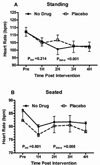Understanding the placebo effect in clinical trials for postural tachycardia syndrome
- PMID: 24606242
- PMCID: PMC4005784
- DOI: 10.1111/1440-1681.12221
Understanding the placebo effect in clinical trials for postural tachycardia syndrome
Abstract
Postural tachycardia syndrome (POTS) is characterized by excessive increases in heart rate (HR) upon standing. Previous studies have shown that standing HR decreases over time in POTS patients given placebo. We hypothesized that this reduction is due to cardiovascular physiological alteration, as opposed to psychological benefit from perceived therapy. To prospectively test this hypothesis, we examined the effects of an open-label 'no treatment' intervention (NoRx) compared with a patient-blinded placebo on standing HR in POTS patients. Twenty-one POTS patients participated in a randomized cross-over trial with oral placebo versus NoRx administered at 0900 h. Seated blood pressure (BP) and HR were measured at baseline and every hour for 4 h. Similarly, BP and HR were measured while patients stood for 10 min at these time points. Standing HR decreased significantly over time with both NoRx (112±13 and 103±16 b.p.m. at baseline and 4 h, respectively) and placebo (112±14 and 102±16 b.p.m. at baseline and 4 h, respectively; Ptime<0.001), but this effect was not different between interventions (Pdrug=0.771). Postural tachycardia syndrome patients have exaggerated orthostatic tachycardia in the morning that decreases over time with either placebo or NoRx interventions, suggesting this phenomenon is due to cardiovascular physiological variation. These data highlight the need for a placebo arm in haemodynamic clinical trials in POTS and may have important implications for the diagnosis of these patients.
Trial registration: ClinicalTrials.gov NCT00262470.
Keywords: diurnal variability; placebo; postural tachycardia syndrome.
© 2014 Wiley Publishing Asia Pty Ltd.
Conflict of interest statement
None
Figures

References
-
- Schondorf R, Low PA. Idiopathic postural orthostatic tachycardia syndrome: an attenuated form of acute pandysautonomia? Neurology. 1993;43:132–137. - PubMed
-
- Jacob G, Biaggioni I. Idiopathic orthostatic intolerance and postural tachycardia syndromes. Am J Med Sci. 1999;317:88–101. - PubMed
-
- Thieben MJ, Sandroni P, Sletten DM, Benrud-Larson LM, Fealey RD, Vernino S, Lennon VA, Shen WK, Low PA. Postural orthostatic tachycardia syndrome: the Mayo clinic experience. Mayo Clin Proc. 2007;82:308–313. - PubMed
-
- Benrud-Larson LM, Dewar MS, Sandroni P, Rummans TA, Haythornthwaite JA, Low PA. Quality of life in patients with postural tachycardia syndrome. Mayo Clin Proc. 2002;77:531–537. - PubMed
Publication types
MeSH terms
Substances
Associated data
Grants and funding
LinkOut - more resources
Full Text Sources
Other Literature Sources
Medical

